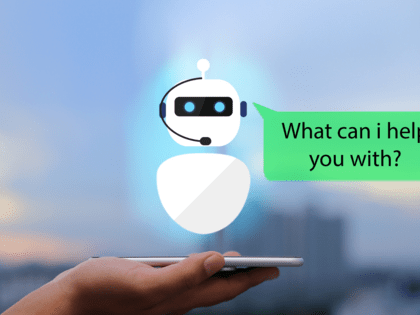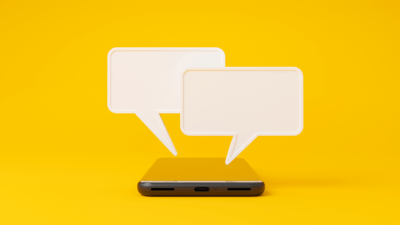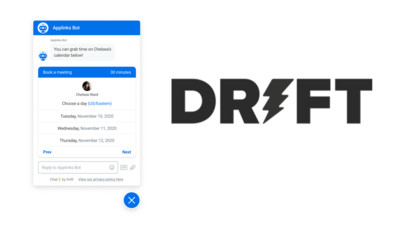Chatbot Marketing Strategy Using Drift

What is a Chatbot?
You’ve probably seen a lot of chatbots lately as you’ve surfed the web, and you’ve probably heard of marketing teams using them as an inbound marketing strategy. A chatbot is a cost-effective computer program that uses artificial intelligence to communicate with customers online and help them find their needs. Case studies show that chatbots regularly create a more personalized experience as well.
Chatbots can be found all over the internet, popping up quickly when you visit websites, including well-known digital services like HubSpot. They give automated answers to your questions when you ask them, collect data, and connect with qualified leads. Chatbots have become increasingly popular recently, appearing on countless websites, social media and messaging platforms, and mobile apps. They are especially important marketing tools for B2B marketers and are, without a doubt, changing how businesses approach conversational marketing and e-commerce.
5 Types of Marketing and Sales Chatbots Your Business Can Use
There are several varieties of chatbots that marketing and sales teams use to interact with potential customers, and these different chatbots can perform a wide range of important duties. There are five worth talking about that can fall under the marketing and sales chatbots category. They perform numerous marketing and sales functions using artificial intelligence and digital routing and come with their sciences, challenges, protocols, benefits, and metrics.

-
Button-based Chatbots: If you’ve ever visited a website and seen a menu of buttons with predefined CTAs and topics for which the website answers commonly asked questions. These are button-based chatbots. They are very straightforward and basic but are nonetheless effective.
-
Support Chatbots: Support chatbots use artificial intelligence and are well-equipped to have engaging conversations with potential customers. They have a deeper understanding of context, and if the conversation exceeds their scope of understanding, they know how to connect potential customers with real salespeople so they can talk more in-depth.
-
Keyword Recognition-based Chatbots: Also known as agent-assist bots, these bots can recognize keywords and understand the context behind them in conversations. They can use their knowledge of keywords to find customers' needs and direct them toward this information. Their automated programming ensures they can assist with onboarding and the monitoring and delivery of tickets, which they can also complete through social media.
-
Voice Chatbots: These bots respond to voice commands. You can talk to them, and they will respond. It’s a lot like talking to the more advanced varieties like Siri and Alexa. They can analyze the questions you ask and answer them. They can also direct you to suggested resources if the need arises.
-
Social Media Chatbots: These chatbots interact with customers on social media. They are often used through messaging platforms like Facebook Messenger, Telegram, Slack, Twitter, LinkedIn, and WhatsApp. They use their AI to answer questions, increase lead generation, and promote the business they work for.
-
Chatbots and Email Marketing: Chatbots are extremely helpful in collecting data about your website visitors that can be used in email marketing — including collecting the email addresses themselves. They can also be programmed to offer items of value, such as an ebook, as a further way to collect information.
Customize and improve purchasing experiences today
Pros and Cons of Using A Chatbot
Chatbot Pros
-
24/7 Availability: With the absence of real sales reps to speak to, website visitors can depend on chatbots at any time, thanks to automation and artificial intelligence. The customer experience can still be fulfilling and doesn’t need to be delayed as long as the website and the chatbots are updated and in good working condition.
-
Faster and More Effective Customer Service: While the sales team can provide decent customer service in most cases, chatbots can direct customers to more information much faster. Customers spend less time waiting and can take things at their own pace as chatbots lead them through processes step-by-step in a way that is easy to understand and regularly follow up with them. They create long-term customer satisfaction and increase conversion rates thanks to these actions.
-
Lower Need For HR: Chatbots can handle many of the duties performed by HR employees, so businesses that use them can save money and resources. The chatbots can keep in contact with the business’s employees virtually and guide them through issues they would normally speak to another human about. The chatbots can also tell if the issue is beyond their programming, requires a human brain, and can direct the team member to the appropriate parties. They can even connect customers to live webinars. These are ways that chatbots make both the employee experience and the customer experience more satisfying.
-
Extremely Promotional: Chatbots make a rock solid case for conversational marketing. They benefit software as a Service (SAAS) businesses and B2B marketers. They not only allow a great online experience for the customers, but because they are found all over the internet and have so many integrations, they can promote their respective businesses quite well and keep attracting new customers and convincing others to return.
Chatbot Cons
-
Language Barrier: Sadly, not every chatbot can process and understand all forms of language like most humans can. While chatbots can speak multiple languages, they don’t understand all speaking styles. If a conversation goes outside their standard scope of vocabulary and pre-programmed functions, there’s not much they can do to sustain an engaging conversation.
-
Limited Accuracy and Abilities: As talented as chatbots can be at Customer Relationship Management (CRM), there are still limitations to what they can do. Every chatbot variety is different, so not all of them can give a customer everything they want. Their communication skills can only go so far, and they can’t replace every creative, flexible, and improvisational ability a human possesses. While chatbot functionality could be changed with further scientific and engineering breakthroughs, businesses need to work with what they have for now.
-
Emotional Blockade: Most chatbots are not yet advanced enough to read the complicated emotions of the site visitors they interact with. On the other hand, salespeople can understand and effectively react to specific human emotions and show emotions in return.
-
Onboarding and set-up: Chatbots are a helpful and modern resource, but they take a fair amount of effort to ensure they are set up and functioning correctly.
What is Drift?
Drift is a SAAS company and conversational marketing platform created in 2015 by co-founders and entrepreneurs Elias Torres and David Cancel. Drift has become widely popular across the internet for its top-tier content strategy and utilization of chatbots. Drift provides pointers, guides, and other resources, and other websites on the internet discuss in depth what Drift can do and why it is important.
Harness marketing automation tools to earn more inbound leads
Drift Chatbots
Drift is a Chatbot leader. Drift listens closely to customer feedback, constantly collects and analyzes data, and is committed to making their chatbots as efficient as possible. Drift bots are quick and to the point, with excellent routing, and they are constantly being developed and improved so they can perform even more functions and contribute to as many workflows as possible. When customers use Drift bots, they can choose which platforms they want to use them on.

How to Create Drift Playbooks
A playbook is an automated conversation workflow that a chatbot uses to interact with site visitors and connect them with resources. When creating a playbook, remember that your goal is qualifying leads and increasing lead generation (including through content downloads). Your playbook should allow you to do that smoothly and effectively.
Here is an easy step-by-step process for creating a playbook with Drift:
-
Decide on a personality and tone of voice for the bot. If they are a voice bot, what do they sound like? Is the bot calmly professional? Cheerful? Funny? What do they say first, and how do they say it? What makes them stand out to the site visitor when they pop up on the screen?
-
Think through the flow of the conversation, and write the script. What is the desired customer journey? Which questions should they answer — and how deeply do they understand them? How do they approach the answer, and how soon do they start routing?
-
Test, measure, and iterate with your Drift Chatbot to ensure maximum effectiveness.
Drift Chatbot Marketing Strategy
Chatbot Strategy
-
Bot Objectives: The bot is programmed with a defined set of goals and objectives that it knows how to meet when interacting with a defined target audience. There should be a clear content model that the bot can refer to so it knows what to suggest and where to route.
-
Bot Personality: The bot should have a distinctive personality that is engaging and unique. The bot should be easy to find and, if possible, have an aesthetically pleasing design. The dialogue it emits should stand out to potential customers browsing the webpage.
-
Customer Experience: The bot should provide the customer with an interactive and personalized experience. The interactions should also be short, sweet, and easy to understand. The bot should be well-versed in customer courtesy as well.
-
Updates and Development: Make sure to track chatbot-related data. Analyze how the chatbot’s performance has been influencing the customer experience. Keep the chatbot’s programming updated, check it as often and take it just as seriously as you would your business’s website. Technology is always changing, and there are ways you can redesign your chatbots and expand the scope of their abilities to fit your business goals.
Playbook Strategy
Here are some key things to pay attention to when creating a playbook:
-
Greeting: Make sure that the greeting is attractive and welcoming. Potential customers should feel like the chatbot cares about helping them and has something to offer them.
-
Questions: Keep in mind what the most commonly questions asked questions will be and have answers ready for them. Make sure that the bot understands multiple variations of the question.
-
Calendar: Have a built-in calendar to easily book additional meetings. This will improve continued communication and make the customers feel more supported.
-
Routing: Make sure that your routing is on point. Bots should know who and/or what to direct the customers to for further assistance.
Conclusion
Now you know the basics of chatbots, what they can do, and how Drift utilizes them. You also know how significant drift is and how they have come to change the world of SAAS. You understand the importance of artificial intelligence and conversational marketing and how they can benefit your business. As complex as the world of chatbot content strategy is, it will only become more complex with technological advancements. That being said, the key takeaway of this article is; to stay on the lookout for unique marketing opportunities that can serve you well.

